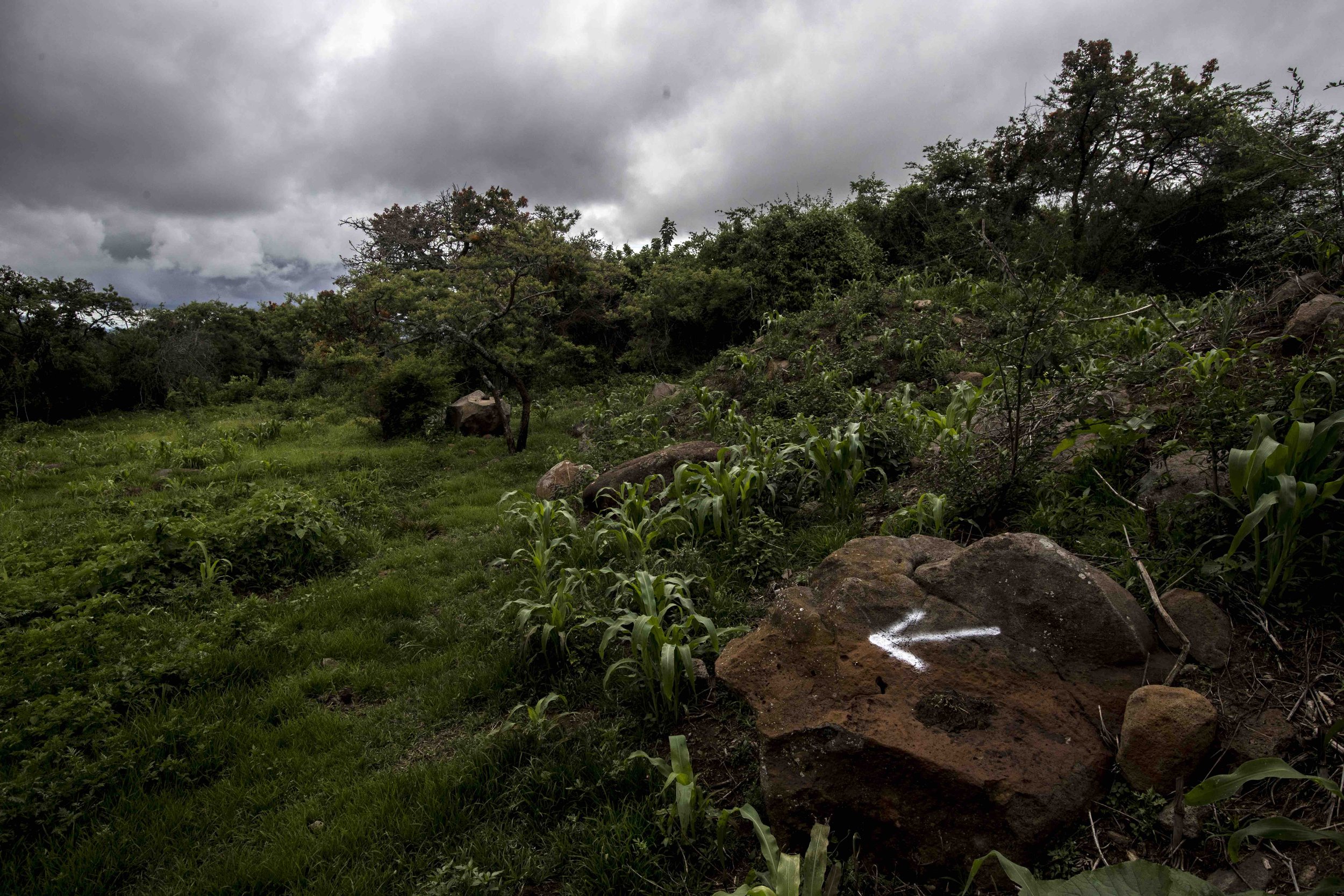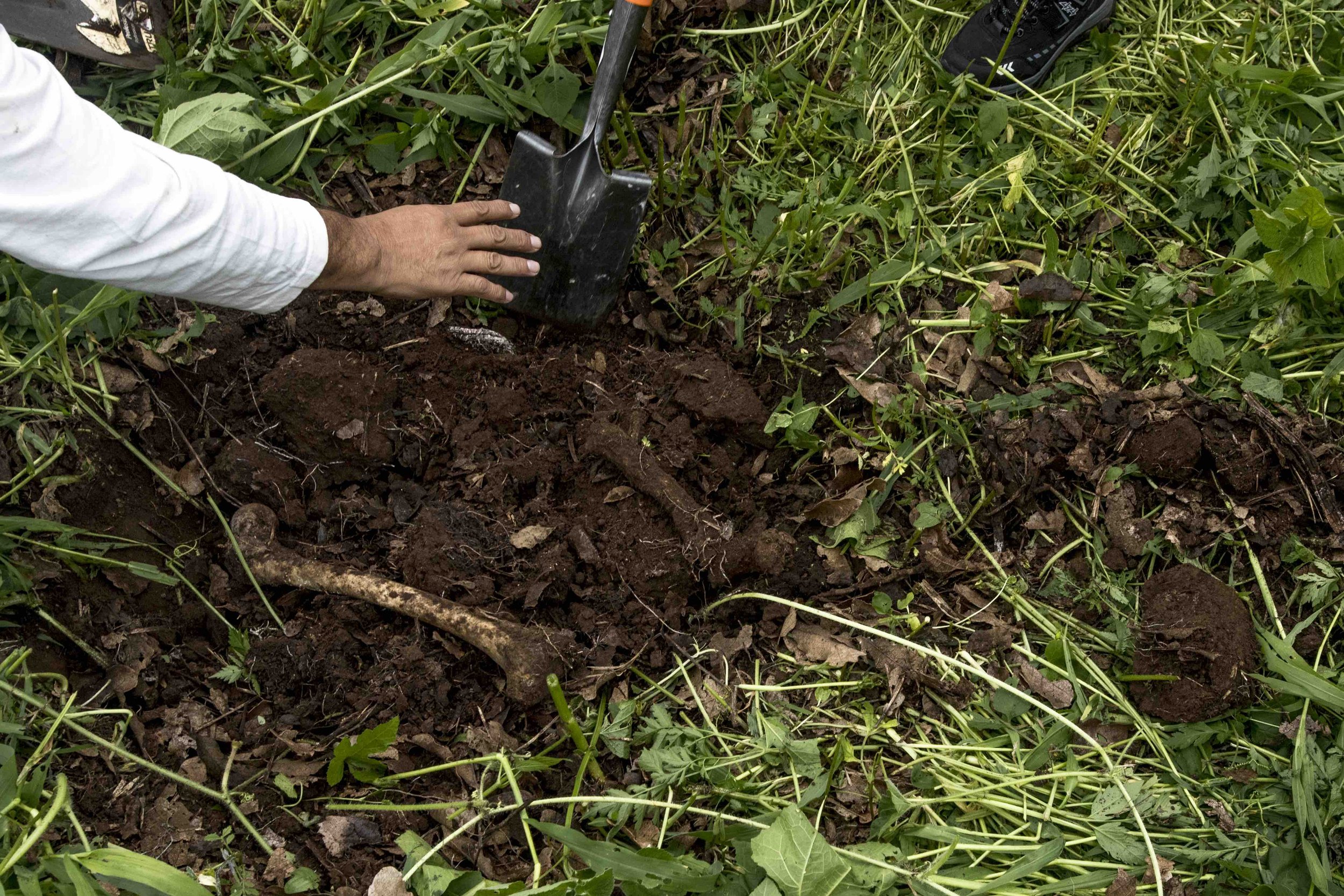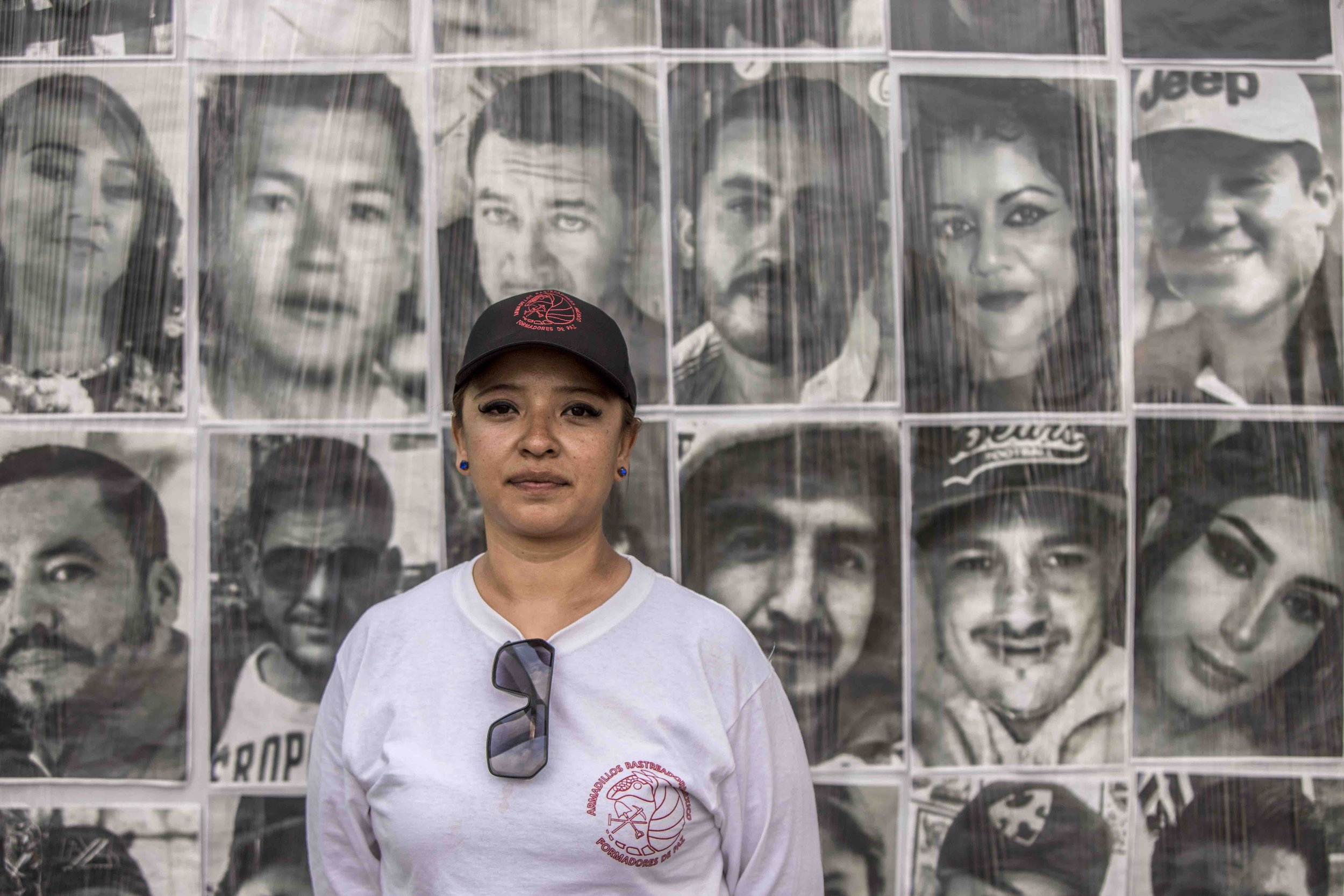Finding community in the search for the disappeared
From left to right, Evangelina, Judith, Sonia, Sebastian, Miguel and Cristina pose for a picture in front of the memorial in the Plaza of Distinguished Men in Zamora, Michoacán, on August 16, 2023. Photo: Ernesto Álvarez.
Reportage • Eliana Gilet and Ernesto Álvarez • October 6, 2023 • Leer en castellano
Miguel Angel Trujillo Herrera sits on a stone wall, his back to a grave he found moments before , when he noticed a femur poking out above the surface. After shovelling a little, he confirmed a "positive," which is how family members participating in searches refer to human remains buried in a clandestine manner.
Trujillo found the grave at his back due to an anonymous tip he received by Facebook message. Everything else, every step of the discovery, was managed by families of the disappeared: they located the area, forced government officials to arrive, organized the search brigade, combed the field, observed, dug, and finally, found the positive.
Miguel Trujillo helped created a method for searching for clandestine graves in Mexico. In the photo, Trujillo walks out of a barn in Santa Ana Pacueco, during the last day of searching in Guanajuato state, on August 16, 2023.
"I’m from Pajacuarán, Michoacán and I am looking for four of my brothers, and now I am looking for all of them", said Trujillo by way of introduction. We spoke less than half an hour after the first positive of the Regional Search Brigade in Michoacán and Guanajuato, which took place during the last two weeks in August.
August 28th marked the 15th anniversary of the disappearance of Trujillo’s brothers Jesús Salvador and Raúl. They were disappeared along with five others with whom they were traveling to the municipality of Atoyac de Alvarez, in Guerrero, for work.
His two other brothers, Luis Armando and Gustavo, were disappeared two years later, on September 22, 2010, along with two of their colleagues as they traveled to Veracruz.
In the face of violence and victimization, the Trujillo family responded by appealing to collective organization. Trujillo remembers the day they decided to found the collective that bears his mother's name: Searching Families María Herrera. The collective was born after her role as spokesperson for the families during the Chapultepec Dialogues with then President Felipe Calderón.
The dialogues were the first example of direct communication between Mexico’s federal government and victims of serious crimes. They came in the wake of mobilizations by the 2011 Movement for Peace and Justice with Dignity, led by poet Javier Sicilia. "When that happened, all the doors opened and I thought: we are going to find them," Trujillo recalled.
The second action that gave the Trujillo Herrera family national prominence was its participation in the movement of family members of the disappeared who began land searches for their loved ones following the 2014 disappearance of 43 students from the Ayotzinapa normal school in Iguala, Guerrero.
The directions to a clandestine grave in Jiquilpan, Michoacán on August 17, 2023. Photo: Ernesto Álvarez.
The mothers and fathers of the 43 students began to go out on their own to do land searches, planting a seed that blossomed as dozens of families formed search groups. Without knowing each other, the families saw in that action the opening they needed to begin to do publicly and collectively something they had been doing alone and in silence.
Around the same time Mayra Vergara, whose brother Tomás Vergara disappeared on July 5, 2012 in Huitzuco, Guerrero, contacted Carlos Trujillo to invite the family to participate in talks in Iguala. There, the Vergara family co-founded another key collective in the growing movement: The Other Disappeared.
Trujillo traveled to Iguala and met with Mayra’s brother Mario Vergara. They too went out into the field to do searches themselves. It was an early example of families of the disappeared overflowing the limits of authority and of what seemed possible in Mexico. At that time, the country had a quarter the number of disappeared persons it has today: at the end of 2014, there were 23,689 people in the National Registry of Missing or Disappeared Persons (RNPED).
Trujillo and Mario Vergara, who passed away earlier, this year joined with Simón Carranza, a supporter from Cocula, Guerrero. The three men developed a strong bond that allowed them to establish a search methodology and share it with other families. Their role is somewhat exceptional, as women, and especially mothers, are the vast majority in this movement.
The methodology they developed was built around a process through which they could receive information from the community, allowing families to locate clandestine burials through clues received anonymously through social media.
A mark left by an informant to help the families locate a clandestine grave that was in an area previously used by local farmers. Jiquilpan, Michoacán, August 17, 2023. Photo: Ernesto Álvarez.
"In social networks news spreads fast through videos, and we invite the population to share any information they have," said Trujillo. "If someone knows something or saw something, they can tell us and we’ll take action."
In April 2016, the Trujillo family launched an initiative that sought to unite multiple, scattered search efforts unleashed after Ayotzinapa, which they called the National Search Brigade. They also helped create a coordinating body called the National Links Network. The Network serves as a space for articulating autonomous searches in the field, and has received support from human rights organizations, such as the Miguel Augustín Human Right Center (Prodh) and the Service for Access to Peace (Serapaz). Eight years later, brigadistas have carried out seven national brigades. Today, over 160 collectives are part of the Network.
"When you see it on GPS or Google Maps, you only imagine it, you don't know what it's going to be until you’re actually there," said Trujillo of the tips he receives.
From the beginning, the National Brigades were a space where families shared the methods they had developed. "It is a circle of teaching: I teach what I know, and tomorrow another colleague will know about it and then she can answer the very questions that I am being asked today," he said.
From local, national and back to local
Evangelina Contreras Ceja joined this circle of knowledge during the third National Brigade, after being displaced from her hometown of Caleta de Campos, on the coast of Michoacan. Her daughter, Tania Contreras Ceja, was disappeared there on July 11, 2012. After participating in the National Search Brigade in Sinaloa, Contreras returned to the coast of Michoacan. There, she tried to replicate what she had learned, but stopped after receiving threats from local authorities.
Evangelina Contreras searches for a second clandestine grave in the Ojo de Rana community in Jiquilpan, Michoacán on August 17, 2023. Contreras is searching for her daughter Tania Contreras Ceja. Photo: Ernesto Álvarez.
Contreras later joined with Laura Orozco, from the Relatives Walking for Justice collective. Together, in April 2019, they carried out their first search in the municipality of Aquila, Michoacán, a conflict ridden coastal area with multiple armed groups and many powerful interests. The women soon located a grave in the town of Tizupan.
Two months later, Zenaida Pulido, one of the searchers who coordinated that search work, was murdered. Her companions denounced the violence as a reprisal against her for daring to search. They demonstrated in front of official buildings in Morelia, the state capital, asking for a stop to the violence and using embroidery as a form of protest.
Contreras went on to form a new group, Victims of Disappearance and Femicide in Michoacán (DECOFEM). When she called Trujillo in 2020 to ask for help with a brigade in his home state, he was ready to go.
In August 2020, a Brigade organized by Contreras and Trujillo located a clandestine burial site in Coahuayana.
The authority was always a step behind. This was evident in Michoacán, where the local Search Commission was created well after the families had gone searching in the field, on their own, even though the General Law of Disappearance mandated its creation in late 2017.
Trujillo warns those digging to stop, as a femur has become visible in Jiquilpan, Michoacán, on August 17, 2023. Photo: Ernesto Álvarez.
The Law created an unprecedented system that separates searches from criminal investigation (which remains under the responsibility of the Prosecutor's Offices). The National Search Commission (CNB) is the authority in charge of the searches at the federal level, and state commissions were to be created in each state at the local level.
According to data from Mexico’s Interior Ministry, by September 2020, the number of disappeared persons had risen to 77,171.
"The search commissioner told me, 'now is not the time to search because of the campaigns,'" Contreras said, in reference to the electoral process leading up to state elections in 2021. "And I would tell him, ‘now is the time, because they are worried about winning, and that's when we can get things done.’"
"After these brigades, many people started to do more searches and contact the CNB," Contreras said in an interview. "More people are out there looking, because it gives them courage when they see us."
Multiply, add or subtract
At the beginning of this year, Contreras contacted Judith Abarca to ask her to take over DECOFEM in the Zamora region, which is near the border between Jalisco and Guanajuato.
"We decided to make DECOFEM regional in Zamora and Jacona," Abarca explained. Her husband, José Antonio Andrade Godínez, was disappeared while driving on October 8, 2021.
Judith Abarca is searching for her husband José Antonio Andrade Godinez. Here, she stands in front of a mural in Zamora, Michoacán, on August 16, 2023. Photo: Ernesto Álvarez.
The Regional brigade in 2023 was the first to be organized by Abarca. She was in charge of making contacts with the civil organization Cáritas, which provided lodging free of charge. Members of religious communities in Zamora provided breakfast and dinner for the people who carried out the searches.
The National and Michoacan Commissions both participated in the Regional Brigade. But the state commission only provided a single van for the transportation, limiting participation to 12 searchers. Usually, around 60 people participate in these searches.
Ceci, Vero and Lupita, local women searchers who asked for anonymity for fear of reprisals, worked throughout the week. So did Sonia and her son Sebastian, who came from Morelia to participate in a search for the first time.
The Regional Brigade found a grave in a field in the municipality of Jiquilpan, Michoacán on Thursday, August 17, 2023, the fourth day of the search. The person who provided the information left marks on the ground to show the families the way to the spot. For a long time, the community had stopped going to that place to enjoy the coolness and shade of the leafy tree that marked the grave. They were well aware of what it hid.
When the searchers reported their discovery to the local Prosecutor's Office, they were told the skeleton could not be removed until the next day due to staffing shortages. The open grave stayed so overnight, without shelter or security.
Everyone present, including Trujillo, said they were saddened by the way the body was found. But it also gave them hope, because it meant that someone would go home. After being exhumed by experts from the Michoacán government the next day, the body was taken to the Forensic Medical Service in Jiquilpan.
The identification of the body is yet another process that families are waiting for. After the discovery of the skeleton in Coahuayana, government workers lost genetic samples taken from the families to make comparisons. Then, the samples were left behind in a warehouse. This is a reflection of the forensic crisis in Mexico, which the federal government recognized in December of 2021, and which means there are 52,000 unidentified bodies in the state’s possession.
Miguel Trujillo stands above a pond in Areo de Rayón, Michoacán, on August 19, 2023, as he seeks to find a grave with two bodies based on an anonymous tip. Photo: Ernesto Álvarez.
Trujillo was born in this area of Michoacan, near the border with Jalisco. Like Contreras,he was also displaced. The Brigade helped him return, he said, because he didn’t visit the site alone. He arrived with the entire Brigade.
"Since I've been here, my hand feels numb, it tingles, because from here I can see my hill, that's where I'm from," said Trujillo, pointing in the distance to the place he grew up.
Over 15 years of searching, Trujillo has seen the number of disappeared persons in Mexico grow to more than 100,000 He’s also seen search collectives of family members multiply in every corner of the country.
"It made me happy to tell everyone that I am from there, from Pajacuarán, and although many people thanked me for holding up my town, what I really wish I could do is put a stop to the disappearances," said Trujillo. "But I can't."











